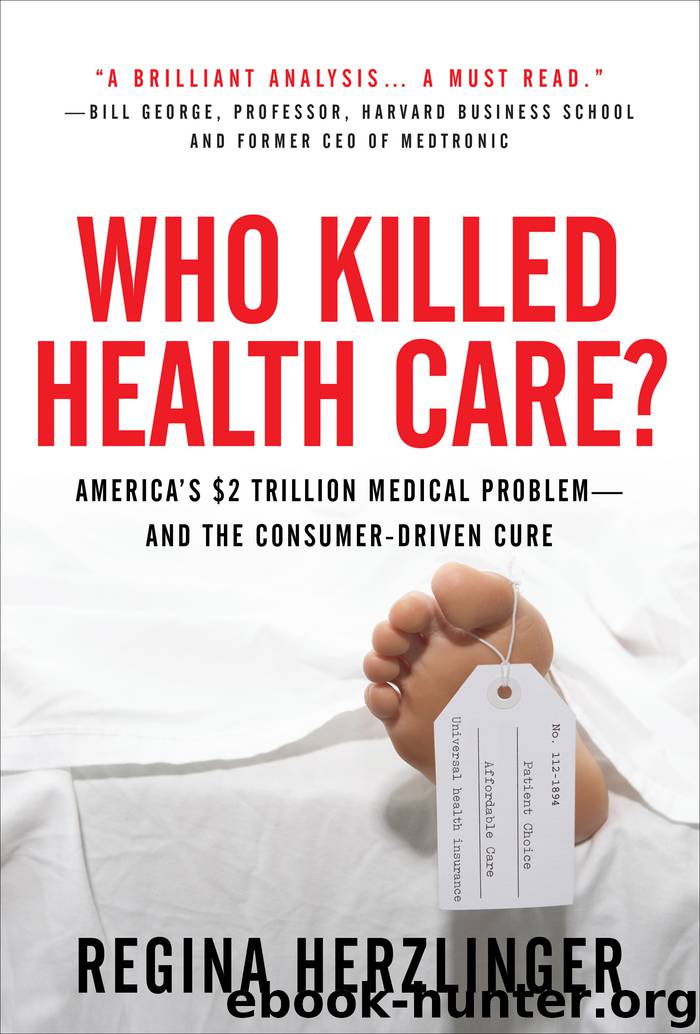Who Killed Health Care? by Regina Herzlinger

Author:Regina Herzlinger
Language: eng
Format: epub
Publisher: McGraw-Hill Education
Published: 2007-03-06T16:00:00+00:00
How Consumer-Driven Health Care Lowers Costs and Raises Quality
Health care draws utopian ideologists of all types. The single-payer crowd rhapsodizes about the transformative powers of government control. But simplistic ideology is not limited to single-payer advocates. Market-oriented adherents also exhibit it.
For example, President George W. Bush's administration asserted that the transformations of consumer-driven health care will occur solely through the implementation of high-deductible health insurance policies.7 They avowed that when people shop for health care services that are not covered by health insurance—from $1, 000 to $5, 000 in the typical high-deductible health insurance policy—they will restrict their usage without damaging their healthstatus. But this plan is only partially consumer driven because it focuses solely on changing demand, which is only part of the picture, and does not allow for the impact of a change in demand on the supply of health care services. If hospitals and other providers of health care services are not motivated to change their ways, the change in demand will accomplish little. After all, the potential impact of high-deductible policies in transforming the supply of health care is limited. Once the deductible is met, most catastrophic expenses are fully insured. And it is the sick who account for thebulk of health care costs.
To be fair, the Bush administration was partially correct—high-deductible health insurance policies, in which the enrollee pays for the first $1, 000 to $5, 000 of health care expenses out of her own pocket, unquestionably lead to lower health care expenditures. For example, a 2006 four-year study of 1.6 million health insurance enrollees found that costs increased by only 3 percent from 2002 to 2005 among those enrolled in high-deductible plans. 8 These cost controls were occasioned by reduced use of hospital emergency rooms. Yet high-deductible enrollees with chronic diseases either maintained or improved their health status.9 High-deductible policies are also a good choice for the uninsured, primarily because those policies cost so much less than traditional policies yet provide insurance for financially catastrophic events.
But high deductibles are not for everyone. After all, if deductibles are not adjusted for income, the average American household, whose after-tax 2004 income was around $45, 000, may well struggle to pay a $2, 000 deductible.10 (On the other hand, the health savings account will enable low-income people to accumulate some much-needed assets for uninsured care.)
High-deductible health insurance policies are one important choice in a consumer-driven system, but they cannot be the only choice. Consumer-driven markets rely on considerable choice, not a choice of one. Consumer-driven health care can improve the productivity of health care only through many varieties of new insurance policies that are tailored to your needs and that increase the health care system's responsiveness to individuals. That is, by changing the form of consumer demand, consumer-driven health care will change supply.
Download
This site does not store any files on its server. We only index and link to content provided by other sites. Please contact the content providers to delete copyright contents if any and email us, we'll remove relevant links or contents immediately.
Hit Refresh by Satya Nadella(9040)
The Compound Effect by Darren Hardy(8817)
Change Your Questions, Change Your Life by Marilee Adams(7637)
Nudge - Improving Decisions about Health, Wealth, and Happiness by Thaler Sunstein(7622)
The Black Swan by Nassim Nicholas Taleb(7016)
Deep Work by Cal Newport(6885)
Daring Greatly by Brene Brown(6449)
Rich Dad Poor Dad by Robert T. Kiyosaki(6413)
Principles: Life and Work by Ray Dalio(6223)
Playing to Win_ How Strategy Really Works by A.G. Lafley & Roger L. Martin(5933)
Man-made Catastrophes and Risk Information Concealment by Dmitry Chernov & Didier Sornette(5924)
Digital Minimalism by Cal Newport;(5667)
Big Magic: Creative Living Beyond Fear by Elizabeth Gilbert(5615)
The Myth of the Strong Leader by Archie Brown(5428)
The Slight Edge by Jeff Olson(5353)
Discipline Equals Freedom by Jocko Willink(5287)
The Motivation Myth by Jeff Haden(5157)
Stone's Rules by Roger Stone(5027)
The Laws of Human Nature by Robert Greene(5001)
